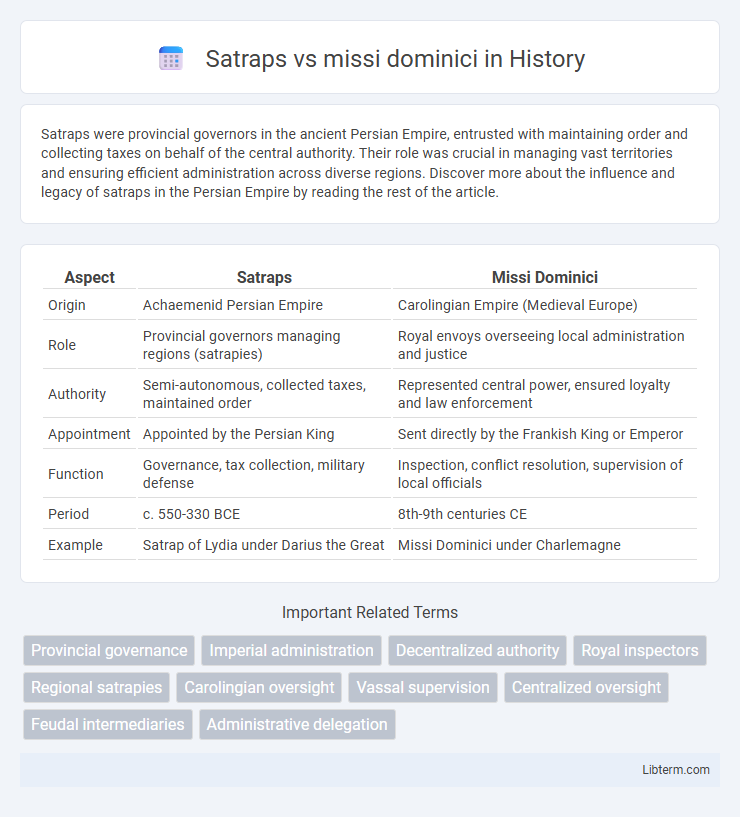Satraps were provincial governors in the ancient Persian Empire, entrusted with maintaining order and collecting taxes on behalf of the central authority. Their role was crucial in managing vast territories and ensuring efficient administration across diverse regions. Discover more about the influence and legacy of satraps in the Persian Empire by reading the rest of the article.
Table of Comparison
| Aspect | Satraps | Missi Dominici |
|---|---|---|
| Origin | Achaemenid Persian Empire | Carolingian Empire (Medieval Europe) |
| Role | Provincial governors managing regions (satrapies) | Royal envoys overseeing local administration and justice |
| Authority | Semi-autonomous, collected taxes, maintained order | Represented central power, ensured loyalty and law enforcement |
| Appointment | Appointed by the Persian King | Sent directly by the Frankish King or Emperor |
| Function | Governance, tax collection, military defense | Inspection, conflict resolution, supervision of local officials |
| Period | c. 550-330 BCE | 8th-9th centuries CE |
| Example | Satrap of Lydia under Darius the Great | Missi Dominici under Charlemagne |
Introduction to Satraps and Missi Dominici
Satraps were regional governors in the ancient Persian Empire, responsible for administrative governance, tax collection, and local security under the authority of the king. Missi dominici were royal envoys in the Carolingian Empire, tasked with overseeing local officials, ensuring justice, and enforcing the ruler's policies across various provinces. Both roles served as extensions of central authority, maintaining control over expansive territories through delegated power.
Historical Origins and Time Periods
Satraps, originating in the Achaemenid Empire around the 6th century BCE, served as provincial governors overseeing vast territories and ensuring loyalty to the Persian king. Missi dominici were royal envoys established under the Carolingian Empire during the 8th and 9th centuries CE, tasked with supervising local administration and justice on behalf of Charlemagne. Both systems reflect hierarchical governance structures but emerge from distinct historical contexts and serve different administrative functions across time.
Geographic Regions of Influence
Satraps governed provinces in the ancient Persian Empire, primarily covering vast territories across Mesopotamia, Egypt, and the Indus Valley, exercising regional administrative and military control. Missi dominici operated within the Carolingian Empire, overseeing local counts and ensuring royal authority in diverse regions spanning modern-day France, Germany, and northern Italy. The distinct geographic regions highlighted the satraps' role in centralized imperial oversight across eastern lands, while missi dominici reinforced decentralized governance in Western Europe.
Roles and Responsibilities
Satraps served as provincial governors in the Achaemenid Persian Empire, responsible for administration, tax collection, and local security while maintaining loyalty to the emperor. Missi dominici were royal envoys in the Carolingian Empire, tasked with overseeing local officials, ensuring justice, and reporting on abuses directly to Charlemagne. Both roles aimed to enforce central authority but operated differently: satraps exercised regional autonomy, whereas missi dominici functioned as itinerant inspectors with limited administrative power.
Appointment and Structure
Satraps were provincial governors appointed by Persian kings to administer vast regions with delegated military and civil authority, often hereditary and structured around centralized royal oversight. Missi dominici were imperial envoys appointed directly by Carolingian rulers, traveling in pairs to supervise local counts and ensure compliance with royal policies, reflecting a decentralized yet monitored governance system. The satrap system emphasized localized control with royal loyalty, while missi dominici focused on accountability and communication between the central government and regional authorities.
Administrative Powers
Satraps served as provincial governors in the ancient Persian Empire, wielding extensive administrative powers including tax collection, law enforcement, and military command within their satrapies. Missi dominici were royal agents deployed by the Carolingian kings to supervise local counts and ensure loyalty, legal compliance, and enforcement of royal decrees across the empire. While satraps operated with considerable autonomy, missi dominici acted as a check on regional authorities, reinforcing central administrative control.
Systems of Accountability
Satraps in the Achaemenid Empire operated as regional governors with significant autonomy but were held accountable through centralized oversight by the king, including royal inspectors and communication channels. Missi dominici in the Carolingian Empire acted as royal envoys directly commissioned by the emperor to supervise local counts and ensure enforcement of laws and royal decrees, creating a network of accountability that curtailed local abuses of power. Both systems emphasized hierarchical supervision and regular reporting to maintain control over distant provinces, but missi dominici featured more direct, short-term inspections compared to the longer-term administrative roles of satraps.
Impact on Central Authority
Satraps, as regional governors in the Persian Empire, often exercised significant autonomous power, which occasionally weakened central authority by fostering local loyalties and potential rebellions. In contrast, the missi dominici, deployed by Charlemagne, served as royal envoys who directly enforced central mandates and ensured provincial officials' compliance, thereby strengthening centralized control. The differing approaches highlight the Persian model's semi-decentralized governance versus the Carolingian strategy of reinforcing central authority through oversight and regular communication.
Legacy and Historical Significance
Satraps, appointed by the Achaemenid Empire, established a model of regional governance that influenced subsequent empires by balancing centralized control with local autonomy. Missi dominici, utilized in the Carolingian Empire, reinforced royal authority through itinerant officials who ensured law and justice, shaping medieval European administration. Both systems laid foundational frameworks for managing vast territories, contributing significantly to the evolution of imperial bureaucracy and state governance.
Comparative Analysis: Satraps vs Missi Dominici
Satraps, appointed by Persian emperors, governed large provinces with substantial autonomy, overseeing taxation, military, and local administration, while Missi Dominici, deployed by Charlemagne, functioned as royal envoys inspecting local authorities to ensure loyalty and law enforcement across the Carolingian Empire. Satraps operated within a centralized imperial framework but often wielded hereditary power, contrasting with the Missi Dominici's temporary commissions aimed at strengthening royal control and curbing noble excesses. The comparative analysis highlights Satraps' role in provincial governance versus Missi Dominici's focus on administrative oversight and imperial integration.
Satraps Infographic

 libterm.com
libterm.com